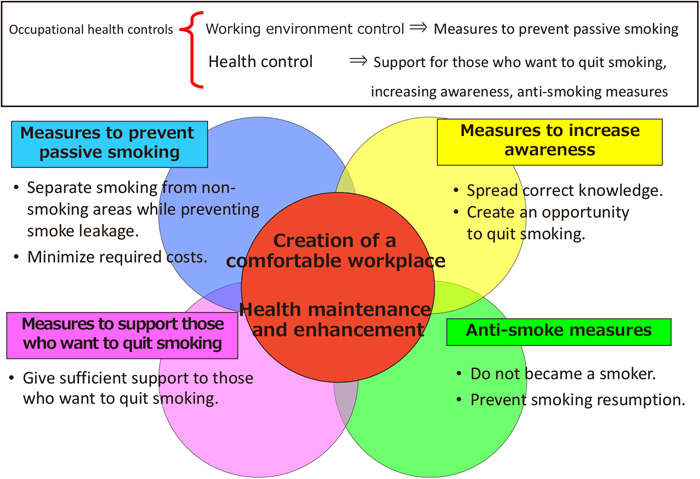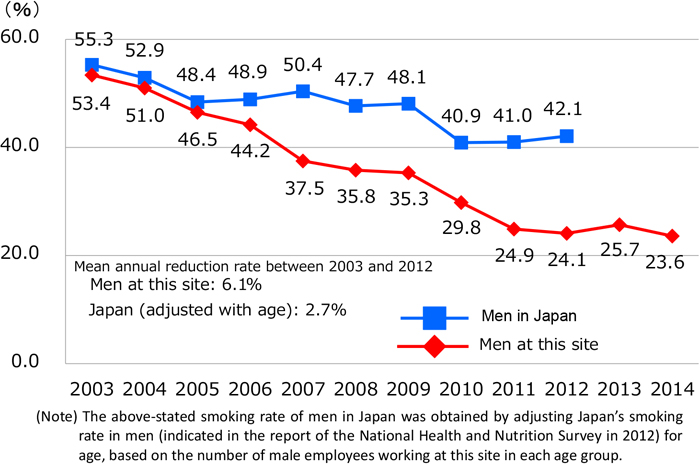2020 Volume 2 Issue 1 Article ID: 2020-GPS02
2020 Volume 2 Issue 1 Article ID: 2020-GPS02
This site has a total area of about 650,000 m2 and is under operation 24 hours a day. In the past, there existed about 200 smoking areas in the site, and 53.4% of male employees smoked in 2003. The smoking cessation measures started with the setting up of smoking rooms and, at present, smoking is prohibited during working hours. Smoking areas inside the building have been abolished, and there are 14 designated days annually during which smoking is prohibited in the entire premises over the full 24 hours of the day. Consequently, the smoking rate among male employees decreased to 24.1% in 2014. At this site, the authors have conducted smoking cessation campaigns while focusing on the following four points: (1) non-smokers should also participate in activities to promote smoking cessation measures; (2) those who want to quit smoking should receive sufficient support; (3) cooperation should be obtained from those responsible for safety and health management at each workplace; and (4) a planned ban on smoking should be made well known at the site far in advance. This report is concerned with the ongoing smoking cessation measures which have been proactively promoted by occupational health professionals to top management, managers/supervisors, and employees.
In 2003, the Guidelines for Smoking Cessation were revised and the Health Promotion Law was enforced, which started smoking cessation measures to reduce the then-current male smoking rate of 53.4%. Initially, we set the final goals, namely to prohibit smoking in the entire premises and to reduce the number of smokers to zero. We gave explanations of the 4 main components (Fig. 1) and 5 objectives (Fig. 2) to the Safety and Health Committee, which approved the incorporation of these components and objectives into the site’s safety and health activity policy.

Four main components of smoking cessation measures at the site

Objectives of smoking cessation measures at the site

Smoking rates among men at this site
The goal was to reduce the male smoking rate to 40% or lower in 3 years. Gradually, the number of smoking areas was reduced by 30% and vending machines for tobacco products were removed. In addition, occupational health professionals visited the workplaces to hold non-smoking seminars (60 seminars held in 2005), and invited slogans on smoking cessation measures. Non-smokers were also asked to participate in the non-smoking seminars, because they were expected to pass on correct knowledge of tobacco to their smoking colleagues or family members so as to encourage them to quit smoking, and to support those who want to quit smoking. Non-smoking seminars were held as collective support, and consultation on non-smoking was given to individuals as individual support.
<5-Year Plan (2008-2012) for Prevention of Lifestyle-Related Diseases>The goals were “to reduce the smoking rate to 25% or lower” and “to initiate the prohibition of smoking during working hours in January 2010.” The prohibition of smoking during working hours was introduced step by step. In 2008, smoking during working hours was limited to 2 times, i.e., once each in the morning and afternoon, at maximum. The system was created to force smokers themselves to take home cigarette butts and tobacco packages with them. In 2009, selling tobacco in the premises of the site was discontinued. As described in the goals, the prohibition of smoking during working hours, except for during break times, was began in January 2010 and has been continued to the present. In 2009, the site was registered as a certified site in which the Occupational Safety & Health Management System (OSHMS) has been introduced in an adequate manner, in compliance with the procedure provided by the Japan Industrial Safety & Health Association, and as a result of which the smoking cessation measures were incorporated into the OSHMS.
<Toward the prohibition of smoking on the entire premises of the site (in and after 2013)>On the World No-Tobacco Day in 2007, we prohibited smoking for the first time in the entire premises for 24 hours of the day. Since then, this practice has been implemented on the same day every year. Since 2011, the day on which the regular monthly meeting of the Safety and Health Committee is held has been designated a 24-hour non-smoking day. In 2012 and 2013, the World No-Tobacco Day and the first day of the national occupational health week in Japan were added one by one, and as a result, there are now 14 days annually on which smoking is prohibited for the full 24 hours of the day. In February 2014, the achievements of our activities to date were highly evaluated, and it was officially decided to prohibit smoking on the entire premises starting in 2020.
Comparison with the nation-wide smoking rate of men (adjusted for the age structure of male employees at this site) revealed that the mean annual reduction rate at this site up to 2012 was 6.1%, which was greater than the corresponding figure for Japan, i.e., 2.7%. Even though no funding was required for individual support, we successfully reduced the smoking rate by clearly indicating the final goals, formulating corporation’s short-, middle-, and long-term plans, and taking actions continuously and in a step-by-step manner.
1. Maintain good relationships with top management, managers/supervisors, and employees. (Occupational health professionals should sincerely listen to employees to obtain their opinions and should avoid situations in which occupational health professionals are isolated or confrontational with employees.)
2. Make top management, managers/supervisors, and employees understand the importance of smoking cessation measures. (Occupational health professionals should continue to emphasize that smoking cessation measures not only ensure maintenance of the good health of employees but also contribute to the improvement of employee morale and corporate business performance.)
3. Be sure to analyze potential or identified causes when goals of smoking cessation measures are not achieved. (It is important to clearly indicate final goals, review plans, and even when short- and/or middle-term goals are not achieved, persevere and do not be depressed, but rather continue to take action.)
The authors declare no conflicts of interest.
The committee for continuing education of Japan Society for Occupational Health has responsibility for the synthesis and dissemination of educational opportunities in occupational health, including selection of Good Practice Samples (GPS). This good practice sample was awarded and released in Japanese as the best good practice by the committee (https://gps.sanei.or.jp/). With the permission of the committee for continuing education of Japan Society for Occupational Health and the editorial boards for Environmental and Occupational Health Practice, the GPS was translated into English for publication.